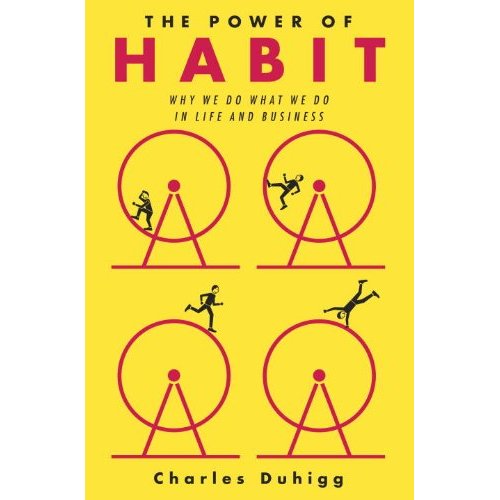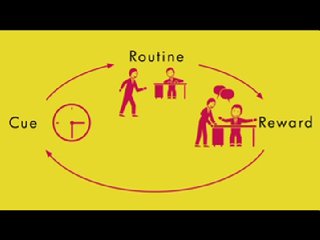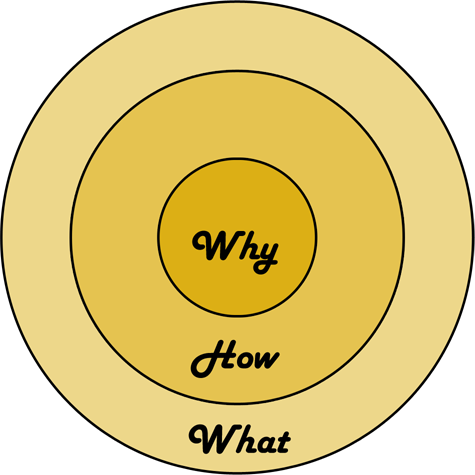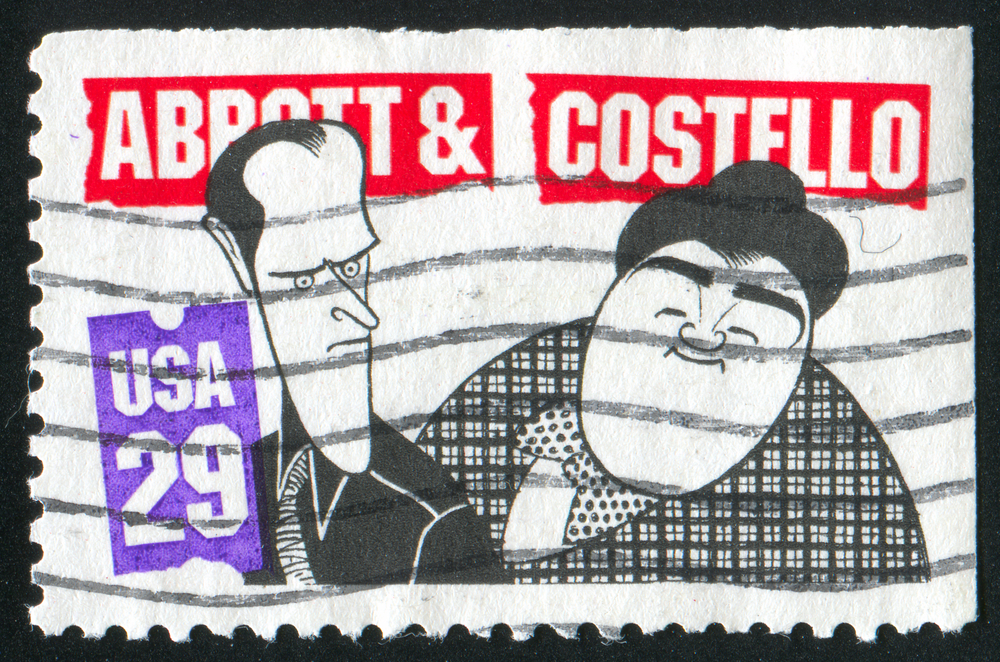Leadership Catalyst Blog
 Our successes and failures seem to be grounded in habits we were lucky enough to make or are too weak to break. Just what are habits, how do they work, and how can we break bad ones and make good ones? Many of the CEOs in my Vistage Peer Advisory Groups are trying to improve their health by changing their habits. As it turns out, the secret to changing habits has huge implications, not only in our personal lives, but in our businesses and in society at large.
Our successes and failures seem to be grounded in habits we were lucky enough to make or are too weak to break. Just what are habits, how do they work, and how can we break bad ones and make good ones? Many of the CEOs in my Vistage Peer Advisory Groups are trying to improve their health by changing their habits. As it turns out, the secret to changing habits has huge implications, not only in our personal lives, but in our businesses and in society at large.
For some answers, check out a wonderful new book, “The Power of Habit: Why We Do What We Do in Life and Business.” You can also check this CNN Video interview (5 min) with the author and Fareed Zakaria and some brief explanations by the author of what you’ll find in the book, including how the CEO of Alcoa turned the company around by changing the safety habits (no kidding) of its employees and how Target can tell which of their customers are pregnant. In another video, (3 min) the author explains the habit breaking technique in detail. If you are really interested in changing your habits, take 8 minutes to view both of these videos.
 I’m about two thirds of the way through the book which looks at role habits play in individuals, companies and society as a whole. One of my favorite stories relates how a US Army officer analyzed the habit of crowds in an Iranian town and significantly reduced the number of riots there by removing the kebab vendors (again, no kidding). Stay tuned to see if his techniques are powerful enough to help me exercise every morning and stop snacking at night.
I’m about two thirds of the way through the book which looks at role habits play in individuals, companies and society as a whole. One of my favorite stories relates how a US Army officer analyzed the habit of crowds in an Iranian town and significantly reduced the number of riots there by removing the kebab vendors (again, no kidding). Stay tuned to see if his techniques are powerful enough to help me exercise every morning and stop snacking at night.
Ten Game Changing Tips for CEO Personal Productivity
All Blog Posts, Motivation, Vistage Peer Groups / 31.05.20121 comments
As members in my CEO peer groups have been getting a grip on their business through the implementation of “Traction”, a new challenge has emerged – How to make the best use of time that was previously spent in countless meetings and in constantly fighting fires. In other words, how do they more effectively use their found time to work “ON” their business rather than “IN” their business.
 Last week we had Steve McClatchy, CEO of Alleer, help us do just that. Most of us had been through various time management programs, and understood the “importance vs urgency” distinction when prioritizing tasks.
Last week we had Steve McClatchy, CEO of Alleer, help us do just that. Most of us had been through various time management programs, and understood the “importance vs urgency” distinction when prioritizing tasks.
However, all too often, urgency trumps importance, and deadlines tend to dictate how we spend our time. This keeps us in a reactive, rather than a proactive mode, which means most of our time is spent managing or maintaining our businesses, rather than leading and improving our businesses.
Here are 10 game changing tips from Steve McClatchy:
1. There are two major categories of tasks — Gain Tasks ( “A” priorities) and Prevent Pain Tasks (“B” & “C” priorities).
“Gain Tasks” produce the greatest results in terms of achieving your goals and improving your life or business. They are things you really want to do, they are motivating, and accomplishing them is energizing and creates the feeling of balance in your life. However, you don’t have to do them, you can’t delegate them, and they are never urgent. These should be your “A” priorities. The only person that can place an “A” on your task list is you. Everyone else’s “A”s are your “B”s and “C”s
“Prevent Pain” tasks are things we “have to” do, and are maintenance tasks which keep us where we are. They will eventually all become urgent, and can burn us out. Prevent Pain tasks are “B” priorities if their results are being recorded and “C” priorities if no one else will know if we completed them or not. Delegate “have to” tasks whenever possible.
2. Intersperse your “A” tasks with your “B” and “C” tasks throughout the day.
This will help you accomplish your “A”s, energize you to accomplish your “B” and “C” tasks, and will create the feeling of balance and movement toward your goals. If you do your Prevent Pain tasks first, you will never get to your Gain tasks and will experience burnout.
3. Schedule your “A” tasks on your calendar to assure they get done.

People make decisions on how to use their time, based on their calendar, not their task list! Getting your “Gain”tasks on your calendar dramatically increases the probability that you will complete them.
4. Have one location to record all of your tasks, appointments, contacts notes and emails.
Keep it with you always, on your smartphone, tablet or PC, and get rid of all floating pieces of paper. For each task or email, touch it only once and decide to :
— Do it now if it takes less than 2 minutes
— Do it later and schedule it on your calendar or to do list.
— Don’t do it ever.
— Delegate it
5. Create daily and future to do lists using tasks in outlook, lotus notes, etc. by entering the date the task is to be started and when it is due.
This is the key to delegation, goal achievement, and stress reduction. Don’t overwhelm yourself and kill your productivity with one giant to-do list. By using an outlook task list, you can parse your master to do list into 365 daily to do lists (one for every day of the year) by simply putting in a start and completion date. Don’t waste time looking at tasks you are not going to get to today. For more ideas, go to: http://www.alleer.com/Article-TMTip1.htm
6. Keep ONE calendar!
You can still keep communication calendars (like work and home), but everything on a communication calendar needs to be on your calendar. You will save yourself an unbelievable amount of time and aggravation if you and your spouse can access one another’s calendars through outlook, google or iCalendar. Make sure everything syncs through the cloud. If you have non-compatible devices (PC/Apple) and don’t have an exchange server, you can “rent” one over the cloud for about $6/month at sherweb.com.
7. Keep great notes!
For a low tech option, keep one spiral notebook that you log all notes chronologically by date.
 Tablet computers are ideal for this purpose. The main challenge is retrieval, so keep it simple and take notes where you can always quickly find them. For example, create an outlook contact for each of your employees, and keep a running journal on all of your conversations in the notes section of each contact. You can also record performance examples there, along with topics you want to cover the next time you talk. Do the same for all of your peers, boss, customers, and even your kids.
Tablet computers are ideal for this purpose. The main challenge is retrieval, so keep it simple and take notes where you can always quickly find them. For example, create an outlook contact for each of your employees, and keep a running journal on all of your conversations in the notes section of each contact. You can also record performance examples there, along with topics you want to cover the next time you talk. Do the same for all of your peers, boss, customers, and even your kids.
There are also applications like onenote, evernote, and notes that let you take notes by date, topic and contact. The advantage with these applications is that they sync with all of your devices so that they are always accessible.
8. Become a power user of Outlook, Lotus notes, or Apple apps.
Learn to drag emails into tasks, calendar and contacts so that you have that information when you need it — When you are working on it or when you are in a meeting. You can also drag tasks into your calendar so you can easily schedule them
Turn your standard emails and templates into “signatures”. You can have over 75 different signatures that contain full emails. The advantage is that when you need to send a standard email, you can click on “new” and then right click anywhere on the signature, which will generate a drop down box with all of your signatures. Click on the one you want, change the salutation and anything else you want to customize, and then hit send.
9. Implement email protocols and best practices.
Email, while a great tool, can be an incredible personal and organizational waste of time. When you calculate all of the time it takes to set up, address, write, and edit an email, most people are only communicating at 5 – 10 words per minute. Contrast this with texting, which is 10 – 20 words per minute, Instant messaging, which is 30 – 40 words per minute, and voice mail, which is 150 – 250 words per minute.
Huge amounts of time can also be saved by having people limit their distributions lists and by not hitting “reply all” on their responses.
Finally, make sure you are managing your email, and not letting it manage you. Turn off your email new item alert window and sound — You have enough interruptions. Check it a couple of times a day, and otherwise, stay focused on accomplishing your “Gain” tasks for the day.
10. Manage interruptions to stay productive and accomplish your “Gain” tasks.
The key, says McClatchy, is to limit the interruption to the 2 minutes of actual work required by the interruption, which usually falls into 3 categories: A task someone wants you to complete, an appointment they want you to schedule, or an exchange of information. For some great tips on how to do this directly and in a way that builds rather than hurts relationships, go to Managing Interruptions.
Read More >>In the 18-minute Ted Video below, Simon Sinek presents a compelling argument that great leaders inspire action in their followers by starting with the “Why” before talking about the “How” or “What”. He illustrates his points using the inspirational examples of Apple Computer, the Wright brothers, and Martin Luther King Jr.
If you haven’t already seen it, I recommend you take 30 minutes to watch the video and then draft a “Why” statement for both your company and yourself. It is well worth the time, and one of the better TED videos that I have seen. It could significantly change your approach in communicating to employees and customers.
[youtube=http://www.youtube.com/watch?v=qp0HIF3SfI4&w=640&h=360]
Sinek says that people don’t buy what you do, they buy why you do it. A key to success as a leader is attracting followers who share your beliefs. When inspiring others to follow you or buy your product, start with “Why”.
In our March Vistage meetings, we watched and discussed this video, and all members (including me) took a stab at drafting a why statement for their businesses, and for themselves.
Here is my take on the Vistage Why, How and What statements.
 Why: Vistage is dedicated to increasing the effectiveness and enhancing the lives of Chief Executives.
Why: Vistage is dedicated to increasing the effectiveness and enhancing the lives of Chief Executives.
How: We accomplish this by helping Chief Executives become better leaders, make better decisions, and get better results.
What: We build and sustain Executive Peer Advisory Groups of chief executives from non-competing business to deliver 4 pillars of value.
- Confidential “Advisory” Peer Group Meetings that meet monthly to address key issues impacting executive decision-making and corporations;
- Private 1-to-1 Mentoring/Coaching Sessions monthly between the Vistage Chair and member executive;
- Expert resources (e.g. speakers, coaches, and “been there done that” CEOs that visit the group meetings regularly)
- Exclusive Content and On-line Connectivity to all 15,000 members and resources developed and improved for over 50 years on the proprietary Vistage Village website.
The next step is to articulate your own “Why” statement, which is more personal, and therefore, more difficult. People often ask me why I became a Vistage chair, having led a large global consulting business for many years.
The reason I became a Vistage Chair is to fulfill my core life purpose, which is to use my gifts, to do what matters, with people who care. Building, sustaining, and belonging to a community of leaders who are committed to one another’s business and personal success is more fulfilling than anything else I can imagine.
So what is your personal “Why” statement? We are looking to add a few more advisory board members that believe what we believe. If you would like to learn more about what it means to belong to an executive peer group that is committed to helping one another grow their businesses, their people, and themselves, call me at 612.877.1234.
Read More >>Some economic humor…And some serious Vistage economic predictions
All Blog Posts, Vistage Peer Groups / 13.03.2012
 As election year heats up, we keep hearing conflicting reports about the labor market’s gains from the economic recovery. At times, the arguments are reminiscent of the “Who’s on First” routine that Abbot and Costello were so famous for. Here is some of that same logic to help us understand how the number of people without jobs is going up while the unemployment rate is going down.
As election year heats up, we keep hearing conflicting reports about the labor market’s gains from the economic recovery. At times, the arguments are reminiscent of the “Who’s on First” routine that Abbot and Costello were so famous for. Here is some of that same logic to help us understand how the number of people without jobs is going up while the unemployment rate is going down.
COSTELLO: I want to talk about the unemployment rate in America.
ABBOTT: Good Subject. Terrible times. It’s 9%.
COSTELLO: That many people are out of work?
ABBOTT: No, that’s 16%.
COSTELLO: You just said 9%.
ABBOTT: 9% Unemployed.
COSTELLO: Right 9% out of work.
ABBOTT: No, that’s 16%.
COSTELLO: Okay, so it’s 16% unemployed.
ABBOTT: No, that’s 9%…
COSTELLO: Wait a minute. Is it 9% or 16%?
ABBOTT: 9% are unemployed. 16% are out of work.
COSTELLO: If you are out of work, you are unemployed.
ABBOTT: No, you can’t count the “Out of Work” as the unemployed. You
have to look for work to be unemployed.
COSTELLO: BUT THEY ARE OUT OF WORK!
ABBOTT: No, you miss my point.
COSTELLO: What point?
ABBOTT: Someone who doesn’t look for work, can’t be counted with
those who look for work. It wouldn’t be fair.
COSTELLO: To whom?
ABBOTT: The unemployed.
COSTELLO: But they are ALL out of work.
ABBOTT: No, the unemployed are actively looking for work. Those who
are out of work stopped looking. They gave up. And, if you give up,
you are no longer in the ranks of the unemployed.
COSTELLO: So if you’re off the unemployment rolls, that would count
as less unemployment?
ABBOTT: Unemployment would go down. Absolutely!
COSTELLO: The unemployment just goes down because you don’t look for work?
ABBOTT: Absolutely it goes down. That’s how you get to 9%.
Otherwise it would be 16%. You don’t want to read about 16%
unemployment do ya?
COSTELLO: That would be frightening.
ABBOTT: Absolutely.
COSTELLO: Wait, I got a question for you. That means they’re two
ways to bring down the unemployment number?
ABBOTT: Two ways is correct.
COSTELLO: Unemployment can go down if someone gets a job?
ABBOTT: Correct.
COSTELLO: And unemployment can also go down if you stop looking for a job?
ABBOTT: Bingo.
COSTELLO: So there are two ways to bring unemployment down, and the
easier of the two is to just stop looking for work.
ABBOTT: Now you’re thinking like an economist.
COSTELLO: I don’t even know what I just said!
And now you know why unemployment figures are improving!
For a more serious treatment of the issue, watch this 8 minute video by Brian Westbury, chief economist at First Trust.
[youtube=http://www.youtube.com/watch?v=fS_LpEs-4Uo&w=480&h=360]
Brian points out that over the last several decades, the official unemployment rate, (currently 8.3 %) is almost perfectly correlated with the jobless rate (aka The U-6 Index) which is currently 15%. Mathematically, the U-6 index is consistently 1.8 times the official unemployment number, and since that ratio has not changed, the gap between the two is not increasing because more people have simply stopped looking for a job. He does suggest that the gap may widen with the aging of our population as the percentage of people over age 60 who want to remain increases.
While we can debate how to best measure unemployment, a couple of facts are evident:
1. The U.S. added more than 200,000 jobs for the third consecutive month. (WSJ – 3/10/2012)
 2. This job growth was predicted by the Vistage Q4 2011 CEO Confidence Index at the end of last year. Here is a quick summary of those results.
2. This job growth was predicted by the Vistage Q4 2011 CEO Confidence Index at the end of last year. Here is a quick summary of those results.
Vistage members were not only more optimistic about prospects for the national economy, but also about the outlook for their own firm’s performance during the year ahead. The Vistage CEO Confidence Index was 98.8 in the fourth quarter 2011 survey, up from 83.5 in the third quarter and reaching the highest level since the start of 2011 (105.2).
Below are some key highlights from the Q4 Vistage CEO Confidence Index:
- 41% of CEOs recognized improved economic conditions over the previous 12 months, up from just 18% in the Q3 survey.
- Only 12% of CEOs thought the economy had recently worsened.
- 73% of CEOs expected revenue growth.
- 55% of CEOs said they plan to increase the number of their employees over the next 12 months, compared with 46% in the Q3 survey.
- 43% of CEOs said the European debt crisis impacts their business.
- 24% of CEOs are finding it easier to obtain credit for their business today compared to 6 months ago.
- 49% of CEOs believe Mitt Romney will emerge as the Republican Presidential Nominee for 2012, while 29% believe it will be Newt Gingrich.
The Vistage CEO index has become a very reliable and accurate predictor for the economy and job growth 2 quarters out. Having these insights into the future provides a competitive advantage to Vistage member companies, and is one of the many reasons that they consistently outperform their non-member peers.
The Q1 2012 CEO confidence index is currently being compiled, and I will post an update in early April
Read More >>CEOs in my Vistage Peer Group candidly reveal the impact the group has had on their businesses
All Blog Posts, Vistage Peer Groups / 13.02.2012
A little over a year ago, I submitted a post citing research that Vistage CEOs outperformed their non-member peers. (http://theleadershipcatalyst.wordpress.com/2010/10/31/research-backs-claims-that-vistage-ceos-outperform-their-nonmember-peers). The bottom line of that article was that
“… in one of the toughest economies in history, Vistage member companies averaged 5.8 % revenue growth, while nonmembers averaged a (9.2%) revenue decline. In future posts, we will explore the factors that contribute to that sizeable performance difference.”
The purpose of today’s post is to make good on that promise. Most of the CEOs who have been in the Vistage Peer Group that I chair have seen significant improvements in their business since they joined. Our group currently has 18 members from a diverse set of industries and backgrounds and businesses that range in size from $5M to over $800M in annual revenues. To better understand how belonging to Vistage increased their effectiveness and enhanced their lives, I took a little flip camera to one of our monthly executive coaching sessions and asked them. (To see all 12 videos, click on the CEO VIDEOS tab at the top of the page.)
For purposes of this blog post, I selected the responses of 3 CEOs from varying company sizes, industries, and business models. Some were struggling a year ago, and others were doing well. All are doing better now and point to their Vistage membership as a key factor in their successes. Below is a brief outline of their situations and links to their 2 minute YouTube videos where they share how Vistage made a difference.
Gene Earhart is the CEO of Wellington Security Systems, a small family business (< $5M) he owns and operates in partnership with his brother-in-law. Gene is a lifelong entrepreneur, who decided to start this business with his family before finishing college. His company designs, installs, and services electronic security systems for the commercial market, and they have 10 employees in a single location. He credits Vistage with helping him turnaround his company to achieve the most profitable year in their 30-year history.
Click here to see a 2 minute YouTube video of Gene telling his story.
Mike Martin is the CEO and owner of Carlson & Stewart Refrigeration ($10 – $25M), which designs, installs, and services industrial and commercial refrigeration systems. An engineer by training, he has worked most of his career at his company, and bought it and became CEO about 8 years ago. Based in Marshall MN, he has about 50 employees in 3 locations in Minnesota and South Dakota. He says that he would not have been able to double the size of his business last year without Vistage.
See Mike’s 2 minute YouTube video by clicking here.
Jim Fisher is the CEO of Midwest Sign, a privately owned business ($100M+) that distributes sign making equipment and supplies. They have about 200 employees in 9 locations throughout the western half of the U.S.. Jim is trained as an accountant, and has spent most of his Career with Midwest. He was thrust into the CEO position about 5 years ago with the sudden and unexpected death of the beloved company owner and founder. After being pounded by the recession, he and his team have hit the restart button on their growth engine, and last year they achieved double-digit growth and record profitability. He points to Vistage as helping him become more strategic, getting him more on top of the business, and showing him how to get a lot more done in less time.
Click here to see more about how Vistage has helped Jim elevate his game as a CEO.
A key theme that cuts across all of these stories is that “None of us is as smart as all of us”. Having an advisory board of fellow CEOs that have your back and challenge your thinking is a tremendous competitive advantage.
Read More >>